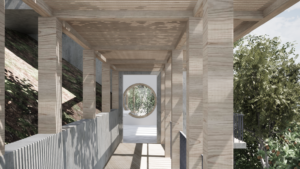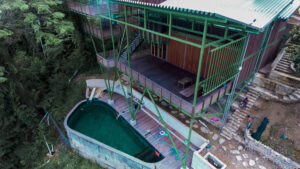I love working on hillside buildings!
There is so much involved in building on a hillside that it challenges my architectural skills.
I believe that a building should become a part of a site and not just be a big blob of an object sticking out like a sore thumb. So it is my duty and that of my team, to walk our clients through the process of building a home on the hillsides that adds to the natural beauty of the surroundings. This is not always easy as we have to contend with nature in so many ways.
Water Management
One of the challenges is water management. As you can imagine, a lot of water comes down from the hillside, especially during the rainy season. There is an option of building big, ugly (in my opinion) retaining walls and concrete culverts to take water to an endpoint with no consideration for the destination. All these are used to beat back the forces of nature. But there are other options that work in harmony with the natural environment.
I’ve worked with Salma Kalloo, who is a very talented young lady on my team, to put together informative diagrams that show how water management can be done using more natural methods. View it here – Hillside Water Management
Getting to the site
Another challenge is that of access. Of course, these hillside houses are usually built way off the beaten path, so getting to the site can be quite tricky. Getting people to the site to work, especially in the early stages is always very interesting. That’s why I do my best to enlist local construction workers in the project from start to finish. Instead of bringing people from hours away, I enlist the services of workers from nearby villages. Some of the advantages of this include:
- Members of the community get much-needed jobs

- They don’t have to spend an exorbitant amount of money on transport out of their community
- I get workers who know the land and can advise on things specific to that area
It also gives me a sense of fulfillment to know that I am adding value to the community in which my company is operating.
Getting The Client To See The Vision
There are many other challenges to building houses up in the mountainside, but it’s what I’ve dedicated my business to. I’m continually developing my skills to face these challenges head-on and find unique ways of overcoming them.
It is also important for me to educate my clients on the ins and outs of building homes on the hillside. This is imperative because my hands are tied if the client does not understand the need to work along with the natural surroundings.
Like I always say, “What the land wants comes first”. But I need to assure my clients that their dreams can become a reality even as we cater to the natural forms of the land.
What’s the best way to help a client overcome the hurdle of understanding the vision? Well, you know what they say, “A picture tells a thousand words!”
I show them renderings of how beautiful their home can be.


Just look at that! Imagine just moving in there, sitting on the balcony and just taking in the view…..Ok, you can imagine later! Let’s continue.
When a client comes to me and requests me to come on their project as an architect, I give them a general breakdown of the project stages. Of course, there are more layers to this, but I believe in presenting information in amounts that can be easily digestible.
For a new site:
- We visited the site – For hillside builds, it usually requires boots, ropes, and nerves of steel! It is usually quite the climb!
- Then we bring in a land surveyor
- We developed a topographical survey
- Build a virtual model -If you would like to see an example of a virtual model, take a look here
- Then it’s on to the stage of the process rendering. This is where we show the client beautiful photos like the ones you saw above.
- Then we are going to start getting specific prices for building materials.
We walk our clients through every step of the process so that they are not just going in blindly. Building these hillside homes can be complicated, so we ensure that our clients are aware of the ins and outs of the project. It is important for us to stick to our core values, one of which is “transparency”. In this case, transparency in communication is extremely valuable since our clients need to feel secure throughout the process. Our team ensures that each client feels comfortable as challenges come up and we find solutions for them.
In the end, it’s a balancing act between preserving the natural contours and curvatures of the land, while bringing the clients’ dreams into reality.
Seeing the final outcome makes it all worth it!








 There are 3 basic principles that define good architecture.
There are 3 basic principles that define good architecture.